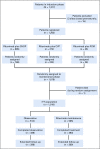Sustained Progression-Free Survival Benefit of Rituximab Maintenance in Patients With Follicular Lymphoma: Long-Term Results of the PRIMA Study
- PMID: 31339826
- PMCID: PMC6823890
- DOI: 10.1200/JCO.19.01073
Sustained Progression-Free Survival Benefit of Rituximab Maintenance in Patients With Follicular Lymphoma: Long-Term Results of the PRIMA Study
Abstract
Purpose: The PRIMA study (ClinicalTrials.gov identifier: NCT00140582) established that 2 years of rituximab maintenance after first-line immunochemotherapy significantly improved progression-free survival (PFS) in patients with follicular lymphoma compared with observation. Here, we report the final PFS and overall survival (OS) results from the PRIMA study after 9 years of follow-up and provide a final overview of safety.
Methods: Patients (> 18 years of age) with previously untreated high-tumor-burden follicular lymphoma were nonrandomly assigned to receive one of three immunochemotherapy induction regimens. Responding patients were randomly assigned (stratified by induction regimen, response to induction treatment, treatment center, and geographic region) 1:1 to receive 2 years of rituximab maintenance (375 mg/m2, once every 8 weeks), starting 8 weeks after the last induction treatment, or observation (no additional treatment). All patients in the extended follow-up provided their written informed consent (data cutoff: December 31, 2016).
Results: In total, 1,018 patients completed induction treatment and were randomly assigned to rituximab maintenance (n = 505) or observation (n = 513). Consent for the extended follow-up was provided by 607 patients (59.6%) of 1,018 (rituximab maintenance, n = 309; observation, n = 298). After data cutoff, median PFS was 10.5 years in the rituximab maintenance arm compared with 4.1 years in the observation arm (hazard ratio, 0.61; 95% CI, 0.52 to 0.73; P < .001). No OS difference was seen in patients randomly assigned to rituximab maintenance or observation (hazard ratio, 1.04; 95% CI, 0.77 to 1.40; P = .7948); 10-year OS estimates were approximately 80% in both study arms. No new safety signals were observed.
Conclusion: Rituximab maintenance after induction immunochemotherapy provides a significant long-term PFS, but not OS, benefit over observation.
Figures



Comment in
-
Answer to Simulation Analysis of Cost-Effectiveness in 2012 Has Finally Come in 2019.J Clin Oncol. 2020 Feb 10;38(5):522. doi: 10.1200/JCO.19.02019. Epub 2019 Dec 5. J Clin Oncol. 2020. PMID: 31804862 No abstract available.
-
Reply to S. Fuji.J Clin Oncol. 2020 Feb 10;38(5):523. doi: 10.1200/JCO.19.02689. Epub 2019 Dec 5. J Clin Oncol. 2020. PMID: 31804865 No abstract available.
References
-
- Freedman A. Follicular lymphoma: 2018 update on diagnosis and management. Am J Hematol. 2018;93:296–305. - PubMed
-
- A clinical evaluation of the International Lymphoma Study Group classification of non-Hodgkin’s lymphoma The Non-Hodgkin’s Lymphoma Classification Project. Blood. 1997;89:3909–3918. - PubMed
-
- Marcus R, Imrie K, Belch A, et al. CVP chemotherapy plus rituximab compared with CVP as first-line treatment for advanced follicular lymphoma. Blood. 2005;105:1417–1423. - PubMed
-
- Marcus R, Imrie K, Solal-Celigny P, et al. Phase III study of R-CVP compared with cyclophosphamide, vincristine, and prednisone alone in patients with previously untreated advanced follicular lymphoma. J Clin Oncol. 2008;26:4579–4586. - PubMed
Publication types
MeSH terms
Substances
Associated data
LinkOut - more resources
Full Text Sources
Medical

